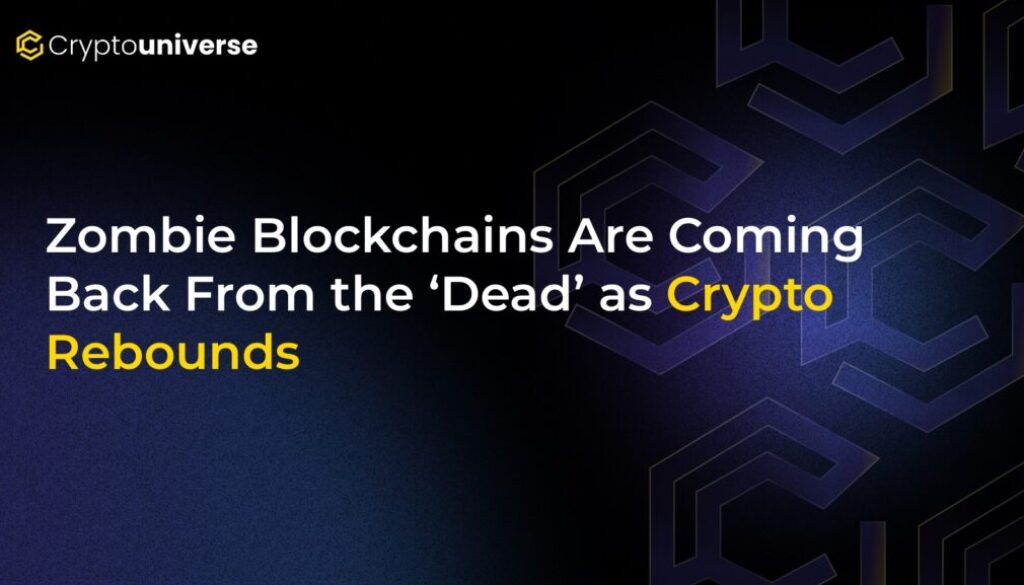Zombie Blockchains Are Coming Back From the ‘Dead’ as Crypto Rebounds

The Crypto Graveyard Isn’t What It Used to Be
Cast your mind back to late 2022. The crypto market was a wasteland. The spectacular collapse of FTX and its sister firm, Alameda Research, sent shockwaves through the industry, wiping out billions in value and vaporizing trust. In the fallout, many once-hyped blockchains, hailed as the future of finance, were left for dead. Their token prices had plummeted, user activity dwindled, and the media hastily wrote their obituaries, labeling them “zombie blockchains.”
Chains like Solana, Algorand, Cardano, and BNB Chain—once titans of the bull market—seemed destined to become digital ghost towns. Yet, something unexpected happened. They didn’t die. Today, these supposed zombies are not just shambling along; they are reawakening with renewed purpose, powered by resilient developer communities and a fundamental shift in the crypto narrative.
This isn’t just another story of a market bounce. It’s a story about evolution, resilience, and how the very purpose of blockchain technology is being redefined before our eyes.
A Narrative Shift: From Digital Coins to Digital Infrastructure
For years, the dominant story around crypto was “coins as money.” Bitcoin was digital gold, Ethereum was programmable money, and every new blockchain promised to be a faster, cheaper version for daily transactions. This narrative, however, hit a wall. Price volatility, regulatory hurdles, and the simple reality that traditional payment systems work just fine for most people limited its mainstream appeal.
Today, a more mature and compelling narrative has taken its place: blockchains as middleware. Instead of replacing currencies, they are now seen as foundational layers—secure, transparent, and tamper-proof rails for a new generation of applications. Their value is no longer solely tied to the speculative price of their native token but to the utility and robustness of their ecosystems.
This reframing has opened the door for so-called zombie chains to find new life. They are becoming the infrastructure for:
- Tokenization: Turning real-world assets (RWAs) like real estate, bonds, and art into digital tokens on a blockchain.
- DeFi (Decentralized Finance): Building complex financial instruments without traditional intermediaries.
- Enterprise Solutions: Providing secure and transparent supply chain management, credentialing, and data verification for large corporations.
- Gaming and NFTs: Powering the next generation of digital economies and collectibles.
Case Studies in Resurrection: The Zombies That Refused to Die
The comeback of these networks is best understood by looking at their individual journeys from the brink.
Solana: From FTX’s Shadow to a DeFi Powerhouse
No blockchain was hit harder by the FTX collapse than Solana. Heavily backed by Sam Bankman-Fried, its token price cratered by over 95% from its peak. Critics, already wary of its network outages, declared it a failed experiment. But beneath the surface, its developer community never stopped building. Retaining one of the most active GitHub repositories in crypto, they quietly improved the network’s stability and performance.
Fast forward to today, and Solana has roared back to life. It’s now a leading platform for memecoins, high-speed decentralized exchanges (DEXs), and innovative consumer apps, proving that its core value proposition of speed and low cost remains highly attractive.
Algorand: The Academic’s Pivot to Institutional Finance
Founded by MIT cryptography pioneer and Turing Award winner Silvio Micali, Algorand boasted impeccable technical credentials. However, it struggled to gain market traction and its token price languished, earning it the “zombie” tag. During the bear market, Algorand quietly repositioned itself. Instead of chasing retail hype, it focused on becoming an institutional-grade solution for serious, compliance-heavy applications. Today, it’s a strong contender in the race to tokenize real-world assets and build infrastructure for central bank digital currencies (CBDCs).
BNB Chain: Defying Gravity and Regulatory Headwinds
As the in-house blockchain of Binance, the world’s largest crypto exchange, BNB Chain’s fate seemed inextricably linked to its parent company. When Binance faced intense regulatory scrutiny from the U.S. government in 2023, many predicted the chain would crumble. Instead, the BNB Chain ecosystem demonstrated surprising resilience. It remains one of the most used blockchains in the world by daily active users and transaction volume, particularly in gaming and dApps, proving it has cultivated an identity and utility independent of the exchange.
Cardano: The Slow and Steady Approach Pays Off
Cardano has long been criticized for its slow, methodical, and research-driven development process. While other chains rushed to market, Cardano prioritized peer-reviewed papers and formal verification. During the hype-fueled bull runs, this made it seem sluggish—a ghost chain in the making. However, in a post-FTX world where security and reliability are paramount, Cardano’s deliberate approach is now seen as a major strength. Its strong, dedicated community and focus on sustainability are attracting projects that value long-term stability over short-term gains.
Why Survival Is the Ultimate Credibility
In the brutal, cyclical world of crypto, simply surviving a bear market is a powerful testament to a project’s legitimacy. The chains that endured the 2022 crypto winter have proven several things:
- Technical Resilience: Their networks continued to operate under extreme market stress.
- Community Loyalty: Their developers and users stuck around even when the financial incentives disappeared.
- A Genuine Vision: They were driven by more than just market hype.
This hard-won credibility makes them far more appealing to large institutions and enterprises than the latest, untested blockchain project. They have existing infrastructure, battle-tested technology, and established developer ecosystems ready to build on.
The Future is Built on Resilient Rails
The resurrection of these Zombie Blockchains Are Coming Back From the ‘Dead’ as
The so-called zombies of yesteryear are now prime candidates to become the foundational rails for this new, tokenized economy. Their near-death experience wasn’t an ending—it was an incubation period that forged them into something stronger and more relevant than ever before.


